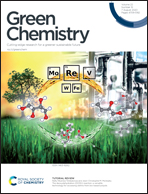Dehydrochlorination of PVC in multi-layered blisterpacks using ionic liquids
Abstract
PVC is often found in composite materials and dehydrochlorination has been shown to be a viable option to recover valuable carbon forms and HCl from PVC, however, in current processes, the high temperature of operation is still detrimental. Ionic liquids were shown to tackle this issue by reducing the temperature of dehydrochlorination and improving its yield. The aim of this work is to address the separation problems associated with mixed composite materials and provide insight into the use of dehydrochlorination as a potential feedstock recycling process, such as, cracking or hydrocracking. To this end, a multicomponent blisterpack containing PVC/aluminium/oPA was chosen to study the separation and dehydrochlorination of a mixed waste. Three ionic liquids with different anions were chosen for this purpose, i.e. trihexyl(tetradecyl)phosphonium chloride, bromide and hexanoate. The results showed that ionic liquids are capable of separating the layered components in the blisterpack and improving the dehydrochlorination degree significantly (up to 99%). The recyclability was shown to be reproducible with halide-based ionic liquids, whilst with the hexanoate anion, the recyclability was achieved by washing with sodium hydroxide, with simultaneous separation of the second polymer (namely oPA). Efficient separation of the layers in the blisterpack was observed using ionic liquids which also allows recycling of the PVC through dehydrochlorination.



 Please wait while we load your content...
Please wait while we load your content...